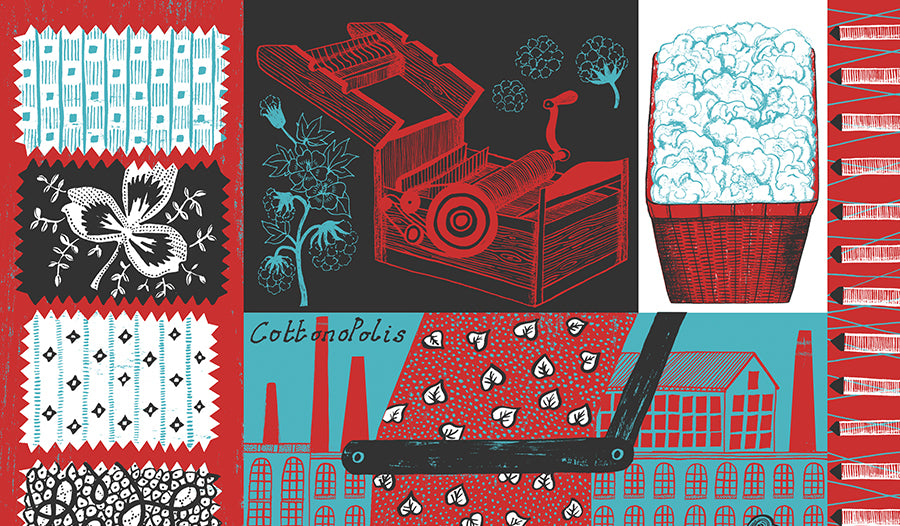
MANCHESTER COTTONOPOLIS

‘Cottonopolis’. It was the Victorian industrial dream, a business hub crowned by the Cotton Exchange from where every aspect of the global cotton trade could be orchestrated and every shilling gathered and counted.
From the final decades of the 18th century to the advent of WWII Manchester dominated cotton. Dubbed ‘Cottonopolis’ in 1854 when the Lancashire cotton industry was at its height, the term referred to Manchester and its satellite towns, each specialised in an aspect of the cotton industry. Over two-thirds of the world’s cotton spindles, operated by an army of men, women, and children, spun cotton into thread, wove it into fabric, dyed, printed, and finished it so these ‘Manchester Wares’ could be exported throughout the world.

Taking control of the world’s cotton industry was a major coup for Manchester. Calicos had been imported since the late 17th century, becoming so fashionable and desirable that The Calico Act of 1721 had been instituted to try to protect British made textiles. Coming into fashion at the end of the 18th century, Indian muslins might have been highly profitable for their importer the East India Company, but further undermined British textile sales. The ability to import raw cotton at a bargain price not only supported the calico printing industry, the fustian industry, and stocking making industry but improved their profits. With the addition of mechanisation, by the end of the 18th century Cottonopolis was fulfilling domestic demand for desirable products at a desirable price, cutting costs, and producing enough to fuel a powerful textile export trade.
Manchester’s damp climate suited the raw cotton fibre helping to prevent it from breaking and keeping it smooth throughout spinning and weaving. It was an established area of skilled textile workers, albeit home workers who ran their own looms and finished their own goods. It was also well served by rivers, especially the River Irk, that could power water mills and provide all the water necessary for bleaching and dying so it became the natural home for the cotton industry. Manchester also pioneered the factory system which saw the population more than double within the next century as thousands came to the city for work.
 Image: Illustration by Alice Pattullo
Image: Illustration by Alice Pattullo
With extraordinary entrepreneurial spirit the technological innovators and their investors - the ‘Millocrats’ - created the backbone of the Industrial Revolution, confirming and enhancing Britain’s position as a global empire. They also made available large quantities of affordable and easily laundered cottons – but at what cost?
Unfortunately living conditions in ‘Cottonopolis’ were not considered with the same innovation, and most cotton mill workers lived in a maze of slums that crawled along the filthy banks of the River Irk. Health problems were endemic. Sadly, suffering was also prevalent amongst the child employees of the cotton mills, especially the ‘Parish’ children who were supposed to receive an apprenticeship but were in actuality indentured to the mill owners until the age of 21. That is if they lived that long. Child workers often died in industrial accidents and even more frequently died from the starvation rations, filthy conditions, and brutal beatings.

The cotton gin mechanised cleaning the seeds from the raw cotton fibre, radically speeding the process and reducing the costs. With Manchester’s insatiable demand and handsome profits, vast swathes of the southern states of America were quickly devoted to cotton plantations and horrifically they brought in thousands of enslaved people to produce it. By 1861 Manchester’s reliance upon American cotton was so complete that when the Navy blockades of the American Civil War stopped the supply, the mills swiftly ground to a halt. The ‘Cotton Famine’ left thousands of mill workers to starve. Leaders of the Confederate states felt that the famine would pressure the British government into supporting their use of slave labour, and were surprised when it was the cotton workers, those who had the most to lose, who were the greatest supporters of the enslaved plantation workers. Abraham Lincoln thanked the cotton workers for their ‘sublime Christian heroism’, and sent them three ships full of food funded by public subscription; an exchange memorialised by a statue which stands in Lincoln Square in Manchester.
Cottonopolis continued to thrive until WWII then faded as inexpensive easy-care artificial fabrics took off in the 1960s. The legacy of Cottonopolis, perhaps even more than technological innovation, is that the selfless act of supporting abolition pushed forward the case for emancipation for the working man, and was pivotal in winning the Second Reform Act of 1867 which allowed thousands of working men to vote for the first time effectively doubling the electorate.
Written by Sarah Jane Downing.
Excerpt from the article Textile Towns: Manchester Cottonopolis in Issue 100 Anniversary.

We're excited to be hosting an online talk on Wednesday 11 May which will bring together academics, cotton producers, designers and cotton activists to discuss the legacy of cotton from historical and contemporary perspectives.
Book tickets and find out more about the event here:


1 comment
Back in the 1800’s my family worked in the Manchester cotton trade. My Great Grandfather Frederick Dearden built up a Fent Dealership which eventually closed in the 1960’s. In my fabric stash I have the remains of one bolt of beautiful navy blue cotton poplin which came from his shop. I also have a reel of cotton produced by Nassau Mills at Patriccroft. Little bits of Manchesters history.